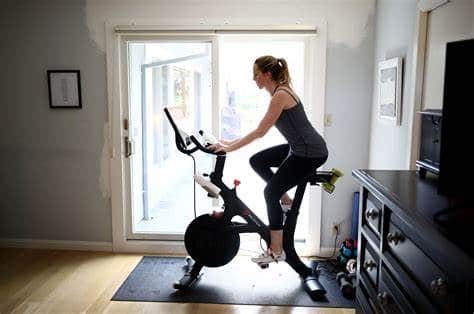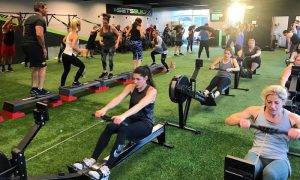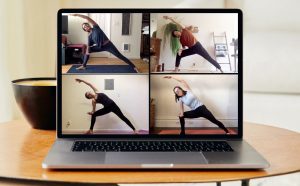
I will start this one off by saying that not all training is created equal.
Yes exercise is exercise, but the way that it is experienced can mean a whole different thing for your results.
For the most part, we all realize at some point that we need to be in better shape than we currently are. And with that comes the realization that we sometimes need help in achieving those goals.
Now where do we start?
Should you do a bootcamp class?
Do I get a Pelaton?
Should I try virtual?
Personal training?
The answer depends on a few things.
We will break down each of these options and cover the pros and cons that will help you decide.
We will start with bootcamp.
So what is a bootcamp?
This class is typically a larger class (sometimes with 20 or more people) where everyone is going through the same exercises at the same time.
Typically, they are high intensity and created with the intention of losing weight and burning as many calories as possible.
The motivation factor is generally higher since you are surrounded by others trying to do the same and you are trying to keep up.
The bootcamp classes may use terms like strength building, fat loss, high intensity classes, but essentially are built around the same premise: work as hard and as fast as you can within the time frame of the class.
classes, but essentially are built around the same premise: work as hard and as fast as you can within the time frame of the class.
Pros:
High motivation factor and typically an energetic environment. You always leave with a sense of accomplishment after the class and can parlay with your fellow boot campers.
Because they often target calories burned, you are highly motivated to bust chops to hit your numbers no matter the cost. You are also for sure to get quick results because of the high intensity factor.
For the most part, bootcamps are affordable and don’t really break bank.
Cons:
Can be intimidating at first, especially if you have not been working out at all. You may feel like you are falling behind and can’t keep up, and get discouraged when you do.
Most of the movements in these classes can not be modified for you if you are dealing with injuries and need more individual attention. This in turn will hurt you more than help you.
If you DO have any movement deficiencies, they are often overlooked as most bootcamp instructors don’t put you through a formal assessment. So, poor mechanics or not, you just amplify them through nonstop motions and compound poor posture or movement integrity.
Let’s not forget the pandemic factor. It still exists. If you are uncomfortable being packed in a room full of others, then it isn’t a good look for you.
Classes often lack expert feedback.
My advice:
If you are in decent shape, can commit to a set schedule, don’t have any injuries that you are dealing with, then I would go for it. These types of high intensity classes should be cycled in conjunction with something specific for you, and not done daily. However, if you are just starting out, or recovering from injury, this is not the best starting point for you.
Virtual Training
Virtual training has really taken off in the past 2-3 years, but especially since last year when covid hit.
Gyms were locked down. Businesses had to pivot. People still wanted to work out but could not. In comes the virtual bootcamp.
Gyms decided we can just stream our workouts through Zoom, and people can do them from home with minimal to no equipment. Problem solved at least temporarily.
 However, there are some training businesses that were doing this long before the pandemic and offering multiple ways to work out virtually besides zoom, like on demand programming delivered through apps, or google sheets in addition to scheduled coaching calls for the one on one benefit.
However, there are some training businesses that were doing this long before the pandemic and offering multiple ways to work out virtually besides zoom, like on demand programming delivered through apps, or google sheets in addition to scheduled coaching calls for the one on one benefit.
Pros:
Convenience. You can wake in do a workout right from your own home. And depending on how the program is structured, you may only need minimal equipment.
If you are working out in a virtual group, then you can still get that motivation factor that prompts you to keep up.
If you are doing one on one virtual coaching, you have a little more customization and a real coaching factor that will keep you accountable. And if using a mobile app, then you have even more resources to help you hit your goals.
Not all virtual coaching programs are created equal. There are benefits to each kind and a range of pricing depending on the coaches level or expertise and approach to training.
Cons:
You most likely don’t want to train virtually forever. Even with a home gym. The motivation factor is different. There is a reason why statistically speaking people who buy treadmills for their home reduce usage of to 75% within their first year of buying. It gets boring and no variety.
With the pandemic, it is also common that people, like “influencers” are taking advantage of this wave of training and see a quick cash grab. They will claim to be an online coach overnight, with pictures of only themselves working out and say “I do virtual programs, DM for questions”.
Sure it may be inspiring at first to look like that, but shallow motivation leads to deep disappointment.
Also, zoom bootcamps can really work, if the instructor is professional and has a real system, but again, the reality is it is tough to stay motivated from home. And if you are a special case like dealing with injuries or are just starting out, virtual bootcamp would be tough for you because of the lack of specificity.
My Advice:
If you are a self-motivated person and already disciplined, then virtual can work for you. This is generally good for Type A personality people as just waking up and getting a task done fuels that self-reassurance.
Again, since not all virtual coaching is created the same, you want to choose the right program. Downloading an app can be good, but it lacks TRUE personalization. Virtual bootcamps can be solid, but you need to make sure you are physiologically prepared for the loads as these classes are more about activity than specifically structured for you.
One on one virtual coaching in my opinion of the best, though depending on the program can be more of an investment. It will be more customized for you, take your current state into consideration, and more personalized accountability.
Take virtual for what it is, and maximize if you choose to do it. Create good habits from it. If you can, I would encourage starting with a personal coach virtually then explore other options.
A Smart Gym?
Have you heard of the Pelaton Bike?
If you have not, then you have not been on planet earth the past 2 years. It is the craze. And for fair reasons:
Technology. Convenience. Motivation.
It is a cross between virtual and a magnified bootcamp experience. You have an instructor yelling at you to keep going, urging you to not give up as you cycle through challenging workouts that you most likely would not do otherwise. 
The Pelaton is one example. Companies like Nordictrack, Bowflex, and others are coming up with training solutions that fill the void of not being able to go to the gym but provide thorough workouts right from home.
Given that the technology is “smart”, they can adjust to you and your needs when necessary. Even controlled remotely by the trainer conducting the session. A piece called Tonal does this.
The other great thing is that the technology can keep metrics of your progress. They can quantify your strength gains, endurance, heart rate improvement and more.
Pros:
They are fun and interactive. If you are not well versed in the gym, it literally takes the thinking away and just serves you the action on a hot platter.
The equipment provides you a variety of different workouts and has a system for staying motivated.
It is like they came just in time for the current climate.
You get options like streaming workouts, live instructors, custom metrics, and adjustments made for you.
The workouts are fun, challenging, and you can do at your pace.
The convenience factor is on one thousand. All this right from your own home.
Cons:
You have to have a high budget, because they are an investment. They often require memberships in order for you to access those streaming classes which is a price on top of the initial investment.
Though the intent of exercise is there, there is still no formal assessment, so if you have underlying issues, you are still only limited to what they have available, and how it is delivered.
For example, if you are already battling low back issues, sitting on a bike hours per week will not help that, and chances are it will take more than just planks. Also, as far as the Peloton, make sure to add programming to combat bad posture created from sitting on the bike.
Even though you do interact with a trainer, the machine and programs themselves lack the social factor you get with going to an actual gym and interacting.
The pandemic will not be around forever, boredom can sink in. Just like any other machine that you buy for the house, after a while you will use it less and less and seek variety.
The future success of your fitness should not be predicated around just a single tool.
My Advice:
If you have the budget, want more out of your home workouts, get motivated from key metrics, value convenience, then the investment could be worth it. It’s fun, it’s different, and has a high motivation factor. Ride the wave…
But just know that all waves hit the shore after a while. Make the most of it, and still aim to stay educated and add variety to your workouts.
The way the world is right now, these things are necessary, but not a means to an end. I am a huge proponent for training technology because I believe when used correctly, you can really unlock your potential.
Personalized Training
Personal training involves committing to a training professional, showing up to a gym or locations, and partaking in a program that is 100 percent customized and made for you.
This can even be done in a small group setting so that you are getting the customization, but also the socialization if you crave.
If you have the right coach, this is the most effective form of training for several reasons; higher investment means more commitment, full customization means you are met where you are and start at your pace, and more accountability.
Pros:
As before mentioned, the customization factor is huge. You have a real person with eyes on you, who if well trained in training themselves, understand the nuances of coaching cues and body mechanics to put and keep you on the right path.
The interaction factor is higher but not quite overload like it would be in a bootcamp.
The accountability factor is higher because you are reporting to a coach that will keep you in check.
Cons:
Not all personal training is created equal. You have trainers, and training professionals. There are so many out there, but many are not the best fit for you. Pay due diligence, research, and choose wisely.
Typically, it is the highest investment for training depending on where and who you choose to use.
There is still that in person factor during the pandemic. If you are not comfortable doing that, then this could be an issue for you.
My Advice:
If you have the budget and are willing to go in person, hiring a training professional is an extremely solid option.
Everyone is a unique individual and that requires unique approaches. A coach can provide this for you.
Doing personal training for at least 3-6 months should set you up to be able to transition into those bootcamps, or maximize your smart gyms, or the virtual bootcamps.
Just perform your due diligence on the trainer and program.
*******
Hopefully this insight provides you some guidance on where the best place for you is to start.
Yes, all people can benefit from exercise, but not every exercise benefits everyone.
Keep the long term in mind when making your decisions, be consistent with your efforts, and trust your body and don’t work too far out of its capable range too fast. Build up to it.
Convenience is great, but don’t compromise your training integrity for the sake of it.
Exercise in a mode that is best for you and add variety. There is no such thing as one best way when it comes to exercise, and your overall fitness.
